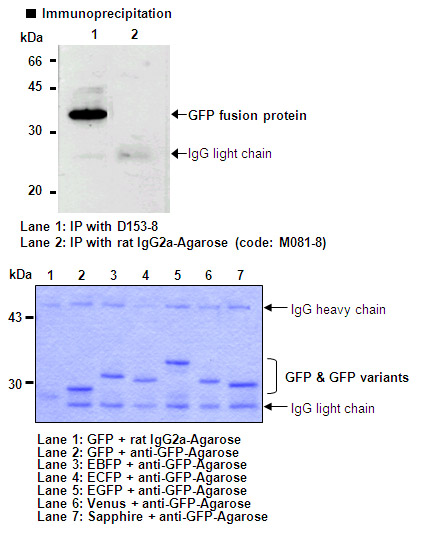Anti-GFP (Green Fluorescent Protein) mAb-Agarose
| Code | Size | Price |
|---|
| MBL-D153-8 | 200 ug | £345.00 |
Quantity:
Prices exclude any Taxes / VAT
Overview
Host Type: Rat
Antibody Isotype: IgG2a
Antibody Clonality: Monoclonal
Antibody Clone: RQ2
Regulatory Status: RUO
Application: Immunoprecipitation (IP)
Shipping:
4°C
Storage:
4°C
Images
Documents
Further Information
Applications:
IP - 20 uL of gel slurry
2 ug of GFP can be precipitated with 20 uL of 50% gel
slurry.
Background:
Since the detection of intracellular Aequorea Victria Green Fluorescent Protein (GFP) requires only irradiation by UV or blue light, it provides an excellent means for monitoring gene expression and protein localization in living cells. Agarose conjugated anti-GFP monoclonal antibody can detect GFP fusion protein on Immunoprecipitation.
Conjugate:
Magnetic Agarose
Formulation:
100 mg of anti-GFP monoclonal antibody covalently coupled to 200 mL of agarose gel and provided as a 50% gel slurry suspended in PBS containing preservative (0.09% sodium azide) for a total volume of 400 mL.
Immunogen Translated:
GFP was affinity-purified anti-GFP by using a mouse from 293T cells expressing GFP
Reactivity:
This antibody reacts with GFP fusion protein on Immunoprecipitation. It reacts with EBFP, ECFP, EGFP, Venus and Sapphire.
Source:
This antibody was purified from hybridoma (clone RQ2) supernatant using protein G agarose. This hybridoma was established by fusion of mouse myeloma cell PAI with Wister rat lymphnode immunized with GFP purified from GFP expressed 293T cells by affinity chromatographic technique using mouse anti-GFP.
Target:
GFP
References
1) Cai, L., et al., J. Biol. Chem. 286, 35915-35921 (2011)
2) Sato, Y., et al., J. Biol. Chem. 284, 11873-11881 (2009)
3) Sakurai, T., et al., J. Cell Biol. 183, 339-352 (2008)
4) Kato, A., et al., J. Virol. 82, 6172-6189 (2008)
5) Dragone, L. L., et al. PNAS. 103, 18202-18207 (2006)
6) Darzacq, X., et al. J. Cell Biol. 173, 207-218 (2006)
7) Hayakawa, T., et al. Plant Cell Physiol. 47, 891-904 (2006)
8) Obuse, C., et al. Nat. Cell Biol. 6, 1135-1141 (2004)




